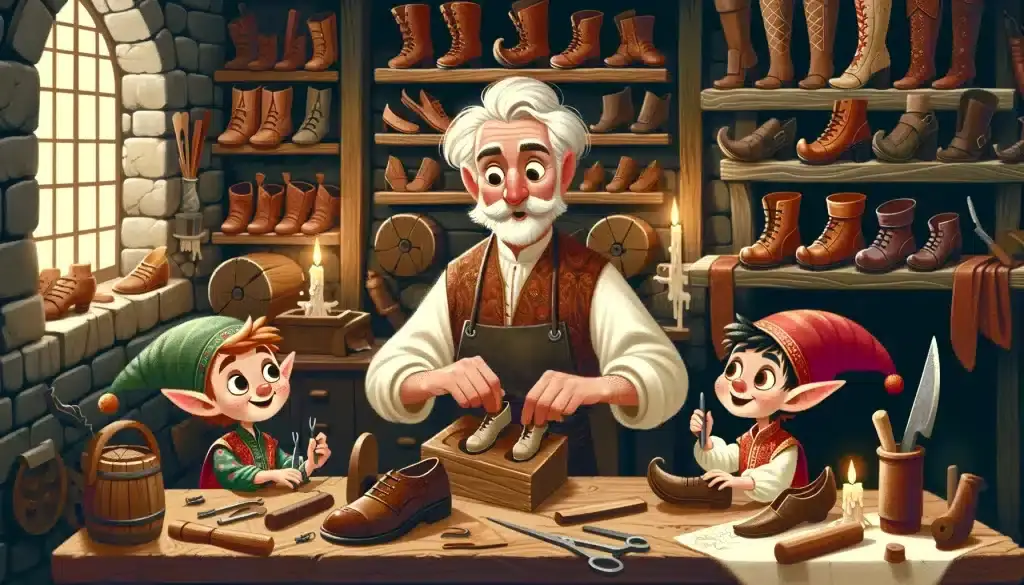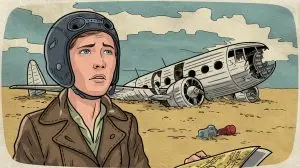“The Elves and the Shoemaker” is an enchanting fairy tale penned by the renowned Brothers Grimm. It tells the story of a compassionate yet impoverished shoemaker who discovers that his workshop becomes the nightly venue for a magical occurrence. As he struggles to sustain his business, help arrives in the most unexpected form—elves, who, under the cover of darkness, expertly craft shoes of the finest quality. Their nocturnal assistance not only revives the shoemaker’s fortunes but also warmth and curiosity into the heart of the craftsman.

The tiny artisans, with their silent dedication and mysterious presence, are central to the story’s charm, and they embody the themes of kindness and reciprocity that the Brothers Grimm often explored in their narratives. The shoemaker’s initial bewilderment swiftly turns to gratitude, leading to a desire to reciprocate the generosity bestowed upon him by his unseen helpers. The delicate interplay between the shoemaker’s newfound prosperity and his sense of ethical responsibility towards the elves adds a layer of depth to this otherwise simple tale.
Characteristically of the Brothers Grimm’s fairytales, “The Elves and the Shoemaker” also imparts a moral lesson: the virtues of hard work, humility, and giving back. It has captivated readers for generations and remains a beloved piece of children’s literature that continues to be cherished for its simplicity, inherent warmth, and the timeless lesson that the smallest acts of kindness can yield the grandest of rewards.
Background of the Tale

“The Elves and the Shoemaker” is a classic tale that stems from the rich collection of German folklore preserved by the Brothers Grimm, Jacob and Wilhelm. Renowned for their dedication to capturing the essence of traditional stories, the Grimms included this narrative as part of their illustrious work on fairy tales, through which they sought to both entertain and impart moral lessons.
- Origin: Published in the early 19th century as part of “Grimm’s Fairy Tales”
- Authors: Jacob and Wilhelm Grimm
- Theme: Kindness and reciprocity
- Influence: Extensive on Western fairy-tales and children’s literature
This story focuses on a humble shoemaker who, through the mysterious assistance of elves, finds himself lifted from the brink of poverty. The tale resonates with the timeless theme of kindness being reciprocated, a common thread found within many of the Grimms’ narratives. Their work has transcended generations, ultimately branding “The Elves and the Shoemaker” as one of the classics of children’s literature. The brothers’ passion for collecting folklore ensured that such fairy-tales didn’t fade into obscurity but rather, continued to spark imagination and teach valuable lessons through their universally friendly and engaging prose.
Plot Overview
In the heartwarming tale of “The Elves and the Shoemaker,” a struggling shoemaker finds his fortunes reversed with the help of mysterious nocturnal allies, leading to a gesture of heartfelt gratitude.
The Plight of the Shoemaker
The shoemaker faces hard times, with leather enough remaining for only one pair of shoes. His grim situation poses a threat to his livelihood, leaving him concerned about how he will continue his trade.
The Mysterious Helpers
Assistance comes unexpectedly as two elves craft exquisite shoes overnight. This miraculous event repeats itself, each time with the elves working diligently and transforming the shoemaker’s remaining leather into masterfully made footwear. This kind act of the elves fuels the shoemaker’s good fortune.
The Shoemaker’s Response
Moved by the kindness of his nocturnal benefactors, the shoemaker and his wife decide to express their gratitude. They tailor tiny garments for the elves, replacing their tattered clothes, as a token of appreciation for the happiness the elves have brought into their lives.
Characters and Setting

In “The Elves and the Shoemaker,” by the Brothers Grimm, we encounter a humble shoemaker and his benevolent helpers, set against a backdrop that underscores the simplicity and hardship of their lives.
Character Descriptions
- The Poor Shoemaker: A kind-hearted man facing poverty, he works diligently to craft shoes but finds himself unable to keep up financially.
- His Wife: Though not frequently mentioned, she is the shoemaker’s supportive partner throughout the narrative.
- The Helpful Elves: A pair of tiny, mysterious beings who arrive and provide assistance, working tirelessly to create exquisite shoes.
The Setting of the Story
The events unfold within the modest confines of the shoemaker’s workshop, a place bearing the marks of wear and frugality. It’s here that the transformation from destitution to prosperity takes place, fostered by the nocturnal visits of the elves. The lack of specific location details gives the story a universal charm, allowing readers to envision the shoemaker’s world as one closely connected to their own realm of understanding.
Themes and Messages

In “The Elves and the Shoemaker,” the narrative weaves through the fabric of fairy tale morality, foregrounding themes such as compassion and the positive outcomes of hard work and generosity. The story communicates its messages through the interactions between the shoemaker, the elves, and the community.
The Virtue of Kindness
In the tale, elves covertly aid the struggling shoemaker, exemplifying kindness without expectation of reward. The shoemaker’s declining business receives a mysterious boon as expertly crafted shoes appear, enabling him to achieve financial stability. The elves’ benevolence models a compassion that is selfless and pure, illuminating the theme that acts of kindness can transform lives.
The Rewards of Generosity
Once the shoemaker discerns the source of his prosperity, his response is not one of exploitation, but rather generosity. Recognizing the elves’ need, he repays their kindness with warm clothing, signaling that giving back is not only just but may also perpetuate a cycle of goodwill. The shoemaker’s wife is equally generous, sharing in the act of giving, which underlines the moral that generous deeds are rewarded, often in intangible but deeply fulfilling ways.
Prosperity Through Hard Work
The narrative further underscores the connection between prosperity and diligence. Initially, the shoemaker toils hard despite scant resources; later, the elves’ own exceptional craftsmanship echoes this work ethic. These parallels highlight that hard work is intrinsic to success and that prosperity can arise from dedication to one’s craft. It suggests that labor, whether by human or magical means, is to be valued and is often the cornerstone of achieving prosperity.
Artistic Elements

In exploring the artistic elements of “The Elves and the Shoemaker,” attention is drawn to the vibrant illustrations found in various adaptations and the central theme of craftsmanship which embodies the story’s moral lessons.
Illustrations in Adaptation
Illustrations play a significant role in bringing to life the magical elements of the tale. Jim LaMarche, for instance, is one illustrator whose work in retelling this classic story has been noted for its warmth and enchanting visuals. LaMarche’s illustrations have a unique way of capturing the kindness and generosity that overflow from the story’s pages.
- Examples of Illustration Quality:
- LaMarche’s use of color and light creates a cozy atmosphere.
- Careful attention to detail shows the elves in the midst of their nighttime labor.
Craftsmanship Portrayed
The theme of craftsmanship weaves through the narrative of “The Elves and the Shoemaker.” The shoemaker himself is a craftsman, one who takes pride in his work—an attribute shared by the elves who help him. Their work is not just about making shoes; it is about the artistry and skill involved in creating quality items that stand the test of time.
- Aspects of Craftsmanship in the Tale:
- The importance of quality and detail in the shoes produced.
- The invisible helpers who embody the spirit of masterful artisanship.
Cultural and Historical Context

“The Elves and the Shoemaker” is a tale that embodies the charm of Grimm’s Fairy Tales, a collection of stories that have been a staple in children’s literature around the world. Compiled by the Brothers Grimm in the early 19th century, the narrative reflects an aura that is both traditional and timeless.
This particular story falls into the category of a classic folktale, with elements that emphasize the virtues of hard work and gratitude. It’s a narrative that transcends the boundaries of a mere children’s story to deliver an endearing message that resonates with adults as well.
The enchanting plot woven by Jacob and Wilhelm Grimm has Christmas undertones, as it often evokes a festive, giving spirit typical of the holiday season. While it’s not overtly tied to Christmas, the story’s themes of generosity and miraculous assistance echo sentiments often associated with the holiday.
In a historical context, tales like “The Elves and the Shoemaker” served not just to entertain but to convey moral lessons and preserve cultural folklore. They often underscored the ethos of their times and were passed down through generations, ultimately becoming an integral part of the traditional canon of Western folk literature.
Adaptations and Influence

“The Elves and the Shoemaker” has been adapted into various formats, resonating well with children and educators due to its lessons in generosity and thankfulness.
Modern Retellings
The timeless story of The Elves and the Shoemaker has inspired numerous adaptations, keeping the narrative fresh and accessible. A notable adaptation by Jacob Grimm is available in a Ladybird book, designed to charm young readers with its simplified storytelling and colorful illustrations. Meanwhile, Jim LaMarche offers a heartwarming retelling accompanied by beautiful artwork, ensuring the story’s themes are conveyed with new creativity and warmth as seen on the curled up kids review.
Presence in Education
Educators widely use “The Elves and the Shoemaker” as a resource to teach kids not only the elements of fairy tales but also the value of kindness. Education World provides tools for children to engage with the story, enhancing learning with activities related to the text. This fairy tale also finds its way into the classroom through various platforms, such as the story’s inclusion in Usborne’s collection, which comes with activities and audio support tailored for language learners.
Teaching and Discussion

In exploring “The Elves and the Shoemaker,” educators have the opportunity to foster curiosity and reinforce patterns in storytelling, while providing a resourceful approach to education through discussion and activities.
Discussion Points
- Comparisons: Invite students to compare the actions of the shoemaker and the elves. They can discuss the themes of kindness and reciprocity, and how these actions impacted each character’s lives.
- Story Elements: Analyze the story’s elements, such as setting, plot, and characters, to help students understand the narrative structure. Discuss the patterns that are common in fairy tales, such as magical assistance, moral lessons, and the rule of three.
Educational Activities
- Role-Play: Have students act out parts of the story to deepen their understanding of the narrative and characters. This can help students explore different perspectives and emotions within the tale.
- Crafting Projects: They can create storyboards or dioramas that depict key scenes. A “shoe-making” craft where they design paper shoes could also be a fun way to engage with the story’s content.
Incorporating storytelling into education not only enhances literary skills but also builds empathy and problem-solving abilities among students.
Conclusion

In the tale of “The Elves and the Shoemaker,” the protagonists experience a heartwarming journey that leaves them, and readers, contemplating the virtues of happiness, compassion, and gratitude. The shoemaker and his wife, once struggling, find their lives transformed by the mysterious help of elves. The nocturnal kindness of these unseen benefactors allows the couple to thrive.
Their fortune, however, is not hoarded. The shoemaker and his wife choose to express their gratitude by crafting tiny clothes for their helpers, a clear act of compassion. The joy this brings to the elves is palpable, emphasizing that the cycle of giving has its own rewards.
This narrative reminds readers that the smallest gestures can lead to immense happiness, and that sharing one’s fortune is both a responsibility and a delight. The story concludes not just with a reversal of the couple’s fortunes, but with the enrichment of their spirits. It underscores the message that generosity and thoughtfulness can triumph in the face of hardship.
By reflecting on these themes, individuals are encouraged to look beyond mere material wealth and find happiness in the act of caring for others. “The Elves and the Shoemaker” thus leaves a lasting legacy — to approach life with a generous heart and to savor the happiness that comes from a life of compassionate actions.
Steve is the creative force behind My Unique Tales, a blog dedicated to sharing captivating stories that explore the human experience in all its complexity. With a passion for writing and a talent for crafting engaging narratives, Steve's blog is a treasure trove of imaginative tales that transport readers to other worlds and challenge them to see things from new perspectives. From epic adventures to intimate character studies, Steve's stories are always thought-provoking and emotionally resonant. With a growing following of readers who appreciate his unique voice and creative vision, Steve is quickly becoming a rising star in the world of online storytelling.






